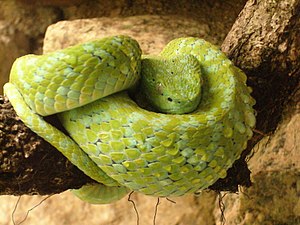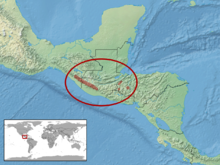Two-colored palm lance viper
| Two-colored palm lance viper | ||||||||||||
|---|---|---|---|---|---|---|---|---|---|---|---|---|

Two-colored palm lance viper |
||||||||||||
| Systematics | ||||||||||||
|
||||||||||||
| Scientific name | ||||||||||||
| Bothriechis bicolor | ||||||||||||
| ( Boucourt , 1868) |
The two - colored palm lance viper ( Bothriechis bicolor ), also Guatemala palm lance viper or two-colored lance viper , is a type of palm lance viper ( Bothriechis ) within the pit viper (Crotalinae). Their range is limited to southern Mexico and the highlands of Guatemala and isolated parts of Honduras .
features
The two-colored palm lance viper reaches a body length of a maximum of about 70 centimeters, with individual specimens also being up to one meter long. As a fully grown animal, it has a green or blue-green basic color, while young snakes are yellow-green in color. The belly side is yellowish green and the tail end is black. As a rule, the snake has no markings, occasionally black spots or bluish areas appear. The top of the head is unmarked and evenly green, and there is usually no temple band. The iris is green.
distribution and habitat
The range of the snake is limited to the eastern Chiapas in Mexico and the highlands of Guatemala . It occurs there only in the mountain rainforests and cloud forests of higher elevations between 1200 and 2300 m. In Honduras it is also isolated in the area of the Sierra de Merendón and the Cerro Santa Bárbara .
Systematics
The two-colored palm lance viper is one of seven species of the palm lance viper ( Bothriechis ) and thus the American pit viper. Until a few years ago, the entire genus was assigned to the American lance otters ( Bothrops ). After the revision of the former large genus by Burger in 1971 and Steven D. Werman in 1992, it was assigned as a separate genus.
Within the palm lance viper it is the sister species of the green and yellow palm lance viper ( B. lateralis ), with which it shares common features of body and head scaling as well as molecular biological features. Together, these two species are closely related to March's palm lance viper ( B. marchi ).
| NN |
|
||||||||||||||||||||||||||||||||||||||||||
|
|
Snake venom
Pit viper poisons contain a mixture of enzymes , low molecular weight polypeptides , metal ions and other components whose function has not yet been fully understood. The effects of these poisons are correspondingly diverse. As with all species of the genus, the poison of the two-colored palm lance viper has tissue-destroying and neurotoxic components.
Individual evidence
- ↑ Steven D. Werman: Phylogenitic Relationships of Central and South American Pitvipers of the Genus Bothrops (sensu lato): Cladistic Analyzes of Biochemical and Anatomical Characters. In: Jonathan A. Campbell, Edmund D. Brodie Jr .: The Biology of the Pitvipers. Selva, Tyler (Texas) 1992; Pp. 21-40, ISBN 0-9630537-0-1
literature
- Brian L. Crother, Jonathan A. Campbell, David M. Hillis: Phylogeny and Historical Biogeography of the Palm-Pitvipers, Genus Bothriechis : Biochemical and Morphological Evidence. In: Jonathan A. Campbell, Edmund D. Brodie Jr. (Eds.): Biology of the Pitvipers. Selva, Tyler (Texas), 1992; Pp. 1-20, ISBN 0-9630537-0-1
Web links
- Bothriechis bicolor in The Reptile Database
- Bothriechis bicolor inthe IUCN 2013 Red List of Threatened Species . Posted by: Campbell, JA & Muñoz-Alonso, A., 2012. Retrieved September 2, 2013.
